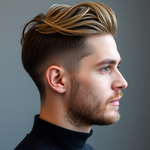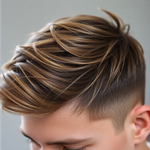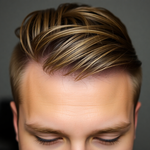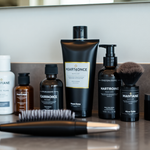Semi-Permanent Hair Color for Men: Subtle Shades That Elevate Your Sustainable Wardrobe
14 August 2025
Share
Intro — Small Move, Big Style Upgrade
Semi-Permanent Hair Color for Men is a simple, low-risk way to refresh your look without committing to heavy chemicals or frequent salon visits. Struggling to balance a polished appearance with a sustainable lifestyle? This method gives you subtle dimension, gray coverage, or tonal tweaks that match a capsule wardrobe — all in under an hour. Read on for a deep dive into shades, step-by-step application, maintenance, and how to pair color with a sustainable closet.
Why Semi-Permanent Works for the Modern Man
Think of semi-permanent color as a temporary upgrade to your natural assets. Instead of chemically altering the hair’s internal structure like permanent dyes, semi-permanent formulas sit on the hair shaft and wash out over time. That means less breakage, less long-term commitment, and more flexibility to change your look with the seasons or your mood.
Science Brief: What’s in the Bottle?
- Pigments: Deposit tone without penetrating deeply.
- Low/no peroxide: Many semi-permanent lines avoid strong developers.
- Conditioning agents: Often include ceramides, botanical oils, or proteins to keep strands smooth.
Brands that prioritize sustainability use plant-derived pigments, biodegradable carriers, and recyclable packaging — things that fit cleanly into an eco-minded wardrobe strategy.
How Semi-Permanent Compares: Permanent vs. Temporary
- Permanent: Long-lasting, covers fully, but requires bleach and developer — more damage and maintenance.
- Semi-permanent: Lasts 4–8 washes, gentler, fades evenly — ideal for experimentation and gray blending.
- Temporary (chalk/gels): Good for a one-night change; washes out immediately but often looks less natural.
Semi-Permanent Hair Color for Men — Best Shades for a Subtle Look
Picking the right tone is key. The goal is enhancement, not cosplay. Below are tried-and-true choices that pair well with neutral, sustainable outfits.
- Soft Chestnut: Adds warm depth; works with olive and medium complexions.
- Ash Brown: Neutral, modern, complements cool-toned clothing like grey and navy.
- Espresso: Deepens natural color for a polished, professional finish.
- Sandy or Honey Blonde: Subtle lightening for sunlit texture — avoid bleach by choosing gentle deposit-only formulas.
- Warm Copper: Gives beards and layered outfits extra pop while staying wearable.
Choosing Color by Skin Tone and Eye Color
Match hair adjustments to your natural coloring for seamless results.
- Cool undertones (blue veins, fair skin): Ashy browns and muted tones prevent brassiness.
- Warm undertones (green veins, tan skin): Chestnut and warm brunettes bring balance.
- Dark brown eyes: Espresso and deep browns add intensity.
- Blue/green eyes: Slightly lighter, warmer tones (soft chestnut, sandy) enhance contrast.
At-Home vs. Salon: Which Route to Take?
Both have pros. Salon pros include customized shade mixing, professional application, and scalp protection. At-home kits are cheaper, private, and convenient. For first-timers wanting minimal change, start with a trusted semi-permanent kit; if you want a custom tone or are blending significant gray, visit a stylist.
Detailed Step-by-Step Application (At-Home, 45–60 Minutes)
- Pick the right shade: One shade darker/lighter than your base color keeps it natural.
- Read instructions: Brands vary — follow timing and mixing directions carefully.
- Patch test: Apply a small amount to skin behind the ear 48 hours prior to check for irritation.
- Prep: Wear an old shirt, protect your neck with petroleum jelly or a towel, and have gloves and applicator tools ready.
- Section hair: Work in 4–6 sections for even coverage, especially if you have thick hair.
- Apply: Start where you want the most change — roots for gray blending, mid-lengths for toning. Use a comb to distribute evenly.
- Process: Keep to the manufacturer’s timing. Don’t leave it on longer than directed to avoid an unnatural look.
- Rinse and condition: Rinse until water runs clear. Use the color-safe conditioner that often comes with kits.
- First wash care: Avoid shampooing for 48 hours if the brand recommends it; otherwise use a gentle sulfate-free wash.
Maintenance: Keep Color Fresh Without Extra Waste
Smart maintenance prolongs color and keeps your routine sustainable.
- Wash 2–3 times weekly to extend pigment life.
- Use sulfate-free, color-safe shampoo and a moisturizing conditioner.
- Rinse with cool or lukewarm water; hot water fades color faster.
- Apply a color-depositing conditioner or gloss every 3–6 weeks to refresh tone instead of re-dying fully.
- Limit chlorine exposure; rinse immediately after swimming.
- Trim split ends regularly — healthier ends hold pigment better and look cleaner in a minimal wardrobe.
Maintenance Schedule (Quick Calendar)
- Week 1: Gentle care, avoid harsh shampoos.
- Weeks 2–4: Regular low-frequency washes, add UV protection when outside.
- Weeks 4–8: Evaluate fading — use a deposit mask or reapply semi-permanent if needed.
Troubleshooting and Fixes
- Too dark: Use clarifying shampoo over a couple of washes; add a vinegar rinse to help lift pigment.
- Patchy or uneven: Apply a color-depositing conditioner to even tone, or see a pro for a corrective gloss.
- Brassy tones: Use a purple/blue-toning product depending on whether your hair is blonde or brown-based.
- Allergic reaction: Stop use and seek medical advice; never skip a patch test if you have sensitive skin.
Styling Tips: Match Hair Tone to Your Wardrobe
Your hair is another piece of your style kit. Subtle coloring should work with your clothing palette, not fight it.
- Neutral wardrobes (greys, blacks, whites): Ash and espresso tones keep looks cohesive and modern.
- Earthy palettes (olive, brown, tan): Warm chestnut and copper enhance natural hues.
- Layered textures (wool, denim, corduroy): Slight tonal contrasts in hair add depth to textured outfits.
Cost Breakdown: Wallet-Friendly Ways to Try Color
- At-home kits: $15–$40 — good for first-timers and subtle changes.
- Salon semi-permanent: $50–$120 — recommended for custom mixing and gray blending.
- Touch-up products (deposit masks, shampoos): $12–$30 — extend life and reduce full re-dyes.
Safe, Sustainable Product Choices
Look for ammonia-free, peroxide-free, and paraben-free labels. Brands that publish ingredient lists and use recyclable packaging align best with a sustainable wardrobe. For safety research and guidelines about hair dye and health, consult authoritative sources such as the American Cancer Society: cancer.org — Hair Dye and Cancer Risk.
Product Picks — What to Look For
- Botanical or plant-derived pigments.
- Conditioning formulas with oils and proteins.
- Clear ingredient transparency and recyclable packaging.
Pair your color choice with sustainable pieces from Menll.com — their outerwear and core staples are designed to complement subtle, natural hair tones. For home grooming context, see Menll.com’s grooming guide for men for more routine tips: Menll.com Grooming Guide.
Real-Life Scenarios: How Semi-Permanent Fits Your Life
Picture this: You’ve got a big pitch next week and want to look sharper without a drastic change. A single session of espresso semi-permanent adds contrast, cleans up your silhouette on camera, and fades naturally if you don’t like it. Or: You’re heading into summer and want a little sunlit texture — a sandy deposit-only gloss will lift highlights while keeping hair healthy.
Common Questions Guys Ask
- Will it damage my hair? Far less than permanent dye. Use nourishing treatments and avoid overlapping with bleach.
- How long does it last? Typically 4–8 washes; denser pigments last longer.
- Can it cover gray? Yes — blends greys well, though very coarse or white hair may require repeated applications or a stronger formula.
Visuals, Alt Text, and Image Guidance

Alt text should be descriptive and include keywords sparingly (e.g., "Man wearing soft chestnut semi-permanent hair color paired with Menll.com sustainable jacket"). Use Jolt to generate tailored hero images that match Menll.com’s minimalist, rugged aesthetic.
Checklist Before You Dye
- Patch test 48 hours prior.
- Choose a shade no more than one level darker or lighter for subtlety.
- Have gloves, applicator, towels, and an old shirt ready.
- Plan for 45–60 minutes; don’t rush the process.
Long-Term Style Strategy
Think of semi-permanent color as part of a broader sustainable style system: a small, reversible tweak that amplifies a minimalist wardrobe. Combine dependable pieces — neutrals, good fits, and long-lasting fabrics — with subtle hair adjustments for a confident, low-waste look that reads intentional, not manufactured.
SEO Meta
Suggested meta title: Semi-Permanent Hair Color for Men — Subtle Shades for a Sustainable Wardrobe
Suggested meta description: Explore semi-permanent hair color for men: low-commitment, eco-friendlier shades that elevate a sustainable wardrobe. How-to, care, and product tips.
Final Note and CTA
Ready to make a subtle change that fits your values and your schedule? Which subtle shade will you try this season? Share your pick below or explore Menll.com’s sustainable wardrobe for outfit ideas that pair perfectly with a new tone.
Vorheriger Beitrag
Semi-Permanent Hair Color for Men: Match Shades to a Sustainable Capsule Wardrobe
Aktualisiert am 15 August 2025
Nächster Beitrag

Subtle Style Reinvention: How Semi-Permanent Hair Color Enhances Your Sustainable Men's Wardrobe with Menll.com
Aktualisiert am 13 August 2025





